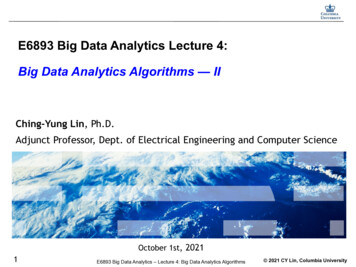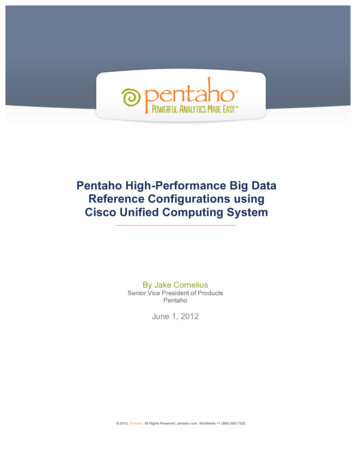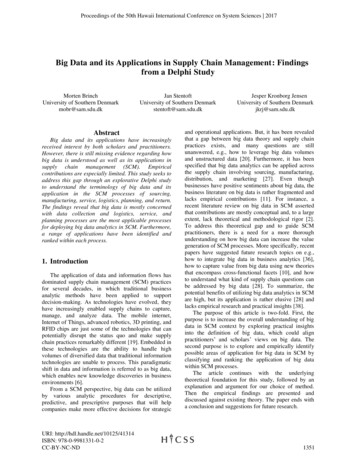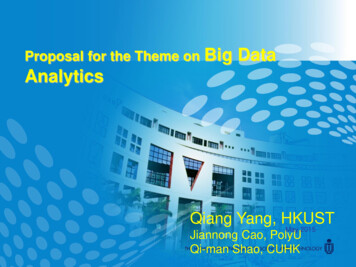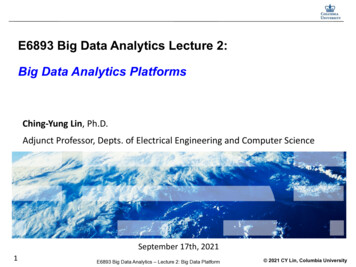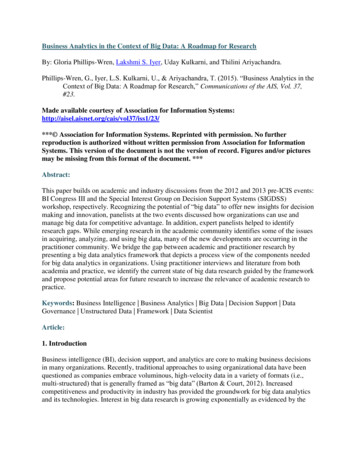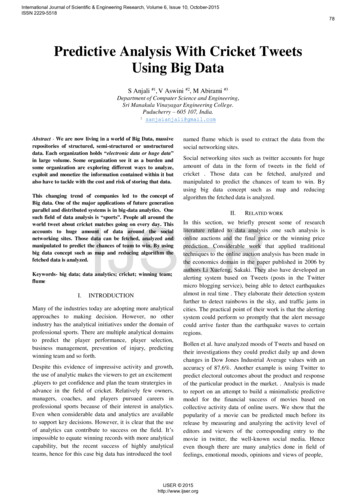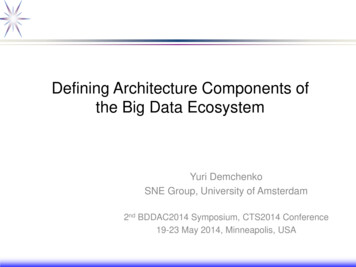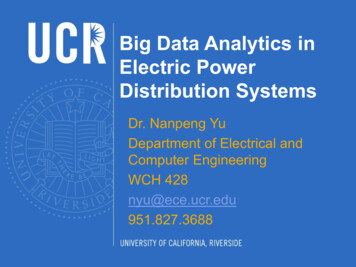
Transcription
Big Data Analytics inElectric PowerDistribution SystemsDr. Nanpeng YuDepartment of Electrical andComputer EngineeringWCH 428nyu@ece.ucr.edu951.827.3688
OutlineWhy do we focus on electric power distribution systems?Big data in power distribution systemsVolume, Variety, Velocity, and ValueBig data applications in distribution systemsElectricity Theft Detection, Detection of Electric VehiclePhase Connectivity Identification, Transformer to Customer AssociationGranular Load Forecast, Solar Adoption ForecastPredictive Maintenance
Why distribution systems?Increasing penetrations of distributed energy resources (DERs) in electricpower distribution systemsE.g. California’s transition to local renewable energy, 12,000 MW by 2020 (peak load50,000 MW)DERsRooftop solar PV systems (1.84 GW of installed capacity by June 2017)
Why distribution systems?Increasing penetrations of distributed energy resources (DERs) in electricpower distribution systemsE.g. California’s transition to local renewable energy, 12,000 MW by 2020 (peak load50,000 MW)DERsEnergy storage systemsIn California 1,325 MW of energy storage will be integrated into the power system by 2020.
Why distribution systems?Increasing penetrations of distributed energy resources (DERs) in electricpower distribution systemsE.g. California’s transition to local renewable energy, 12,000 MW by 2020 (peak load50,000 MW)DERsElectric vehicleIn Nov 2016, the cumulative sales of battery electric and plug-in hybrid sales in Californiahits 250,000 which accounts for 20% of global cumulative sales.
The need for advanced modeling, monitoring,& control of distribution systems!The cold, hard facts about modern power distribution systemsModelingIncomplete topology information in the secondary systems (phase connection,transformer-to-customer mapping)Even the three-phase load flow results are unreliable.MonitoringMost utilities do not have online three-phase state estimation for entire distributionnetworkControlFocus on system restorationLimited predicative and preventive controlVolt-VAR control, network reconfiguration
OutlineWhy do we focus on electric power distribution systems?Big data in power distribution systemsVolume, Variety, Velocity, and ValueBig data applications in distribution systemsElectricity Theft Detection, Detection of Electric VehiclePhase Connectivity Identification, Transformer to Customer AssociationGranular Load Forecast, Solar Adoption ForecastPredictive Maintenance
Big Data in Distribution Systems: VolumeIn 2015, the U.S. electric utilities had about 64.7 million AMI installations.By the end of 2016, almost 50% of the residential customers in the U.S.have AMI infrastructure.The smart meter installation worldwide will surpass 1.1 billion by 2022.In 2012, the AMI data collected in the U.S. alone amounted to well above100 terabytes. More than 2 petabytes of meter data in 2022.
Big Data in Distribution Systems: VarietyAdvanced Metering InfrastructureElectricity usage (15-minute, hourly)RFNeighborhoodArea MeshNetworkWide-Area NetworkWirelessNetworkVoltage magnitudeCell RelayGeographical Information SystemEquipment MonitorsAsset healthCensus DataHousehold variables: ownership, appliance, # of roomsPerson variables: age, sex, race, income, educationSCADA InformationMicro-PMUTime synchronized measurements with phase anglesMeter DataManagementSystem
Big Data in Distribution Systems: VelocitySampling FrequencyAMI’s data recording frequency increases from once a month to one reading every 15minutes to one hour.Micro-PMU hundreds (512) of samples per cycle at 50/60 HzBottleneck in Communication SystemsLimited bandwidth for zigbee networkMost of the utilities in the US receives smart meter data with 24 hour delayEdge Computing TrendItron and Landis Gyr extend edge computing capability of smart metersIncreasing data transmission range and computing capabilities of smart metersCentralized distributed / decentralized
Big Data in Distribution Systems: ValueThe big data collected in the power distribution system had utterlyswamped the traditional software tools used for processing them.Lack of innovative use cases and applications to unleash the full value ofthe big data sets in power distribution systems.*Insufficient research on big data analytics system architecture design andadvanced mathematics for petascale dataIt is estimated that the electric utilities around the world will spend 10.1billion on automated metering infrastructure (AMI) data analytics solutionsthrough 2021.Start-up CompaniesC3-IOT, Opower/Oracle, AutogridRisk of failing to adhere to data privacy and data protection standards.* Nanpeng Yu, Sunil Shah, Raymond Johnson, Robert Sherick, Mingguo Hong and Kenneth Loparo, “Big DataAnalytics in Power Distribution Systems” IEEE PES ISGT, Washington DC, Feb. 2015.
OutlineWhy do we focus on electric power distribution systems?Big data in power distribution systemsVolume, Variety, Velocity, and ValueBig data applications in distribution systemsElectricity Theft Detection, Detection of Electric VehiclePhase Connectivity Identification, Transformer to Customer AssociationGranular Load Forecast, Solar Adoption ForecastPredictive Maintenance
Big Data Applications in Power Distribution SystemsSpatio-temporal ForecastingElectric Load / DERs – Short-Term / Long-TermAnomaly DetectionSystem MonitoringState Estimation & VisualizationElectricity Theft, Integration of EVEquipment MonitoringPredictive MaintenanceOnline DiagnosisCustomer Behavior AnalysisNetwork Topology andParameter IdentificationTransformer-to-customer, PhaseCustomer segmentation, nonintrusive connectivity, Impedance estimationload monitoring, demand response
Electricity Theft DetectionProblem DefinitionEnergy Theft: The activity of reducing electricity bill by altering the electricityconsumption (physical / cyber)Physical: Bypassing the smart meter, tamper electricity metersCyber: Hack into meters, communication network to change kWh readingsWhy is it important? (Business Value)According to Northeast Group, LLC, the world loses 89.3 billion annually toelectricity theft in 2015 (India 16.2 billion).In the North America energy theft costs between 0.5% and 3.5% of annualgross revenue.B.C. Hydro estimates up to 3% of energy theft with 1500 ‘electrical diversions’caught in 3 years.Center Point estimates energy theft is 1% to 2%.
Electricity Theft DetectionPrimary Data SetAdvanced Metering Infrastructure, SCADA, GISTraining data (energy theft cases)Solution MethodsPhysical approachTechnical loss model based method, state estimation based methodDrawback: assume all distribution network topology and parameters are known or can beestimated accurately. Meter readings are required for transformers as well.DistributionTransformerCustomer 1Customer 2Technical Loss Non-technical Loss Total Loss Transformer kWh Reading - CustomerkWh ReadingsCustomer 3
Electricity Theft DetectionSolution MethodsMachine learning approachUnsupervised: anomaly detection on a single time series, supervised: classificationDrawback: Many other factors lead to anomaly in usage pattern, biased training set1.500kwh1.00015-minute Energy Consumption Profile for ResidentialCustomerSep 6, 2013 (High 102F, Low 76F)Jul 23, 2013 (High 86F, Low 66F)0.5000.0001 2 3 4 5 6 7 8 9 10 11 12 13 14 15 16 17 18 19 20 21 22 23 24Hour-0.500Hybrid approachThe voltage magnitude and electricity consumption of the customers under the sametransformer must be in sync. (Kirchhoff Law). Consumption can be fitted with voltage data.Large difference between estimated and metered electricity consumption indicated potentialenergy theft.
Case StudyThree customers are connected to the same center tapped transformerRealistic customer smart meter data with energy theft introducedWhich customer isstealing power?Answer: Customer 2!
Visualization of Energy TheftResidual (Electricity Consumption Estimation)NormalizedResidualDimension ReductionHour
Detection of Electric VehicleProblem DefinitionIdentify which customer(s) have adopted electric vehicleDetect charging of electric vehicle and estimate the power consumption fromcharging activities.Why is it important? (Business Value)When buying a plug-in electric vehicle (PEV), or a plug-in hybrid electric vehicle(PHEV), the consumer has no obligation to inform the electric utility.On average, a typical household draws 0.7 kW of load from their local powerutility. EV draws up to 3.7 kW per hour. This presents a problem because oneEV owner alone can indirectly add 4 household worth of load to a transformer.Unexpected charging of electric vehicles can lead to overloaded assets in adistribution system and premature equipment failure.Targeted demand response / EV charging program info can be distributed to theright group of customers.
Detection of Electric VehiclePrimary Data SetAdvanced Metering Infrastructure, Customer Information SystemCensus Data at Block Group Level (Income, age, vegetation level, No. Rooms.)Training data (customers who informed the utility about EV purchase)Solution MethodsSupervised MLKWh87Semi-Supervised ML 654321Does this household0has an EV?Difficult to detect level-1 charging
OutlineWhy do we focus on electric power distribution systems?Big data in power distribution systemsVolume, Variety, Velocity, and ValueBig data applications in distribution systemsElectricity Theft Detection, Detection of Electric VehiclePhase Connectivity Identification, Transformer to Customer AssociationGranular Load Forecast, Solar Adoption ForecastPredictive Maintenance
Distribution System Topology IdentificationThe distribution system topology identification problem can be brokendown into two sub-problemsThe phase connectivity identification problemThe customer to transformer association problem22
Phase Connectivity IdentificationProblem DefinitionIdentify the phase connectivity of each customer & structure in the powerdistribution network.Very few electric utility companies have completely accurate phase connectivityinformation in GIS!Why is it important? (Business Value)Phase connectivity is crucial to an array of distribution system analysis &operation tools including3-phase Power flowLoad balancingDistribution network state estimation3-phase optimal power flowVolt-VAR controlDistribution network reconfiguration and restoration
Phase Connectivity IdentificationPrimary Data SetAdvanced Metering Infrastructure, SCADA, GIS, OMSTraining data (field validated phase connectivity)Solution MethodsPhysical approach with Special SensorsMicro-synchrophasors, Phase MetersDrawback: expensive equipment, labor intensive ( 2,000 per feeder), 3,000 feeders for aregional electric utility company ( 6 million)
Phase Connectivity IdentificationSolution MethodsInteger Optimization, Regression and Correlation based Approach0-1 integer linear programming (IBM)Correlation/Regression based methods (EPRI)Drawback: cannot handle delta connected Secondaries, low tolerance for erroneous ormissing data, low accuracy and high computational costData-driven phase identification technologySynergistically combine machine learning techniques and physical understanding ofelectric power distribution networks.Unsupervised, supervised, and semi-supervised machine learning algorithmHigh accuracy on all types of distribution circuits, (overhead, underground, phase-toneutral, phase-to-phase)
Case StudySupervisedUnsupervisedVisualization
Transformer to Customer AssociationProblem DefinitionCorrect the connection info between smart meters and transformers in GIS.The current transformer to customer association data is 40% - 90% accurate inU.S. electric utilities’ GIS.Why is it important? (Business Value)Outage reportingIdentify a potential source of a transformer issueSizing transformersPreventive maintenance of transformersElectric vehicle hosting capacity estimation
Transformer to Customer AssociationPrimary Data SetAdvanced Metering Infrastructure, SCADA, GIS, OMSCustomer Information System, Asset Management SystemTraining data (field validated transformer to customer mapping)Solution MethodsPhysical ApproachField validation (visual inspection for overhead configuration)Drawback: time consuming, labor intensive, distribution network topology undergoesconstant changePure Data Driven ApproachLinear regression, logistic regression, correlation based methodVoltage magnitude and GIS information are inputs
Transformer to Customer AssociationHybrid SolutionNonlinear dimension reduction with density based clusteringReal-world data reside on a lower-dimensional space, customers connected to thesame transformer are close to each other on the lower-dimensional feature space.Physically inspired methodMinimum weight spanning tree based method, find the minimum weight spanning tree withsecond order voltage covariance as the edge weight.(A subset of edges of a connected undirected graph that connects all vertices, without any cycles and with theminimum possible total edge weights.)
Case StudyIncorrect Customer toTransformer AssociationField ValidatedCustomer toTransformer Association
OutlineWhy do we focus on electric power distribution systems?Big data in power distribution systemsVolume, Variety, Velocity, and ValueBig data applications in distribution systemsElectricity Theft Detection, Detection of Electric VehiclePhase Connectivity Identification, Transformer to Customer AssociationGranular Load Forecast, Solar Adoption ForecastPredictive Maintenance
Granular Load ForecastingProblem DefinitionElectric utilities have been doing territory wide load forecasting with regression /time series / neural network models.However, load forecasting at feeder / lateral / service transformer level has beendone in an ad hoc manner.Why is it important? (Business Value)Transformer sizingDistribution circuit upgradesDistribution system planningResource dispatch in power distribution systemsDistribution network reconfiguration and restoration
Granular Load ForecastingPrimary Data SetAdvanced Metering Infrastructure, GISCustomer Information SystemCensus Data at Block Group Level (Income, age, vegetation level, No. Rooms.)Solution MethodsOff-the-shelf Time Series ModelsVector Autoregressive Moving Average Model (VARMA)Drawback: Curse of dimensionality, the number of parameters explodeSpatio-temporal ModelsExtended Dynamic Spatial-temporal modelExploit the spatial correlations of the electric load data
Granular Load ForecastingExtended Dynamic Spatial-temporal model (DST)The correlation between feeder loads is stronger when both spatial lag and time lag aresmallThe correlation drops quickly when the spatial lag increases with time lag fixed at 0.DST model: 𝑦 𝑡 𝑣 (Λ Γ𝑊Θ)𝑦 𝑡 1 𝑛(𝑡)Spatial weight matrix 𝑊 characterizes the spatial correlation among different feeders.Exponential distance weights: 𝑤𝑖𝑗 exp( 𝛼ℎ𝑖𝑗 )Neural Network ModelFeedforward neural networkRecurrent and Recursive NetsSpecialized for processing sequential data
Case StudyLoad forecasting results of a sample feeder(a) VAR(1) model(b) Extended DST modelAverage forecasting performance of VAR(1) and extended DST models
Solar PV Adoption ForecastProblem DefinitionPerform spatial-temporal solar Photovoltaic system adoption forecast at thecustomer / feeder level.Separate commercial and residential solar PV adoption forecast models.Why is it important? (Business Value)More accurate forecast of distributed solar PV adoption will greatly facilitatedistribution system planning.Spatial-temporal solar PV adoption forecast serves as an important input tohosting capacity analysis.A solar PV adoption model is a useful tool for policy evaluation (federal andstate incentive programs, CSI, ITC).Understanding the drivers behind the solar PV adoption could help policymakers / utilities improve design of future renewable energy incentive programs.
Solar PV Adoption ForecastPrimary Data SetAdvanced Metering Infrastructure, GIS, Customer Information SystemCensus Data, Historical PV adopter information, FinancingRetail Rate, Historical Installed PV Cost, Incentive Program Data, Roof InfoSolution MethodsDiscrete Choice Experiment with Surveys (EPRI)Identify attributes that influence consumers’ decisions.The attributes were tested with a focus group and then used to develop questions forsurveys administered to more than 2,500 customers.The “choice” mode is built for determining the combinations of attributed likely to drivecustomer preference.
Solar PV Adoption ForecastBass Diffusion ModelThe basic Bass model is well-established to model the innovation and technologyadoption in any market.The probability of adoption of a new product at time T given that it has not yet beenadopted would depend linearly on two forces, innovation 𝑝 and imitation 𝑞.𝑓 𝑡1 𝐹 𝑡 𝑝 𝑞𝐹(𝑡)Generalized Bass Diffusion ModelTo include “marketing effort”, the GBM is introduced.𝑓 𝑡1 𝐹 𝑡 𝑝 𝑞𝐹 𝑡 𝑥(𝑡)We shall call 𝑥(𝑡) “current marketing effort”, reflecting the influence of market factors onthe adoption rate at time t.𝑥(𝑡) could represent energy savings, government incentives, etc.
OutlineWhy do we focus on electric power distribution systems?Big data in power distribution systemsVolume, Variety, Velocity, and ValueBig data applications in distribution systemsElectricity Theft Detection, Detection of Electric VehiclePhase Connectivity Identification, Transformer to Customer AssociationGranular Load Forecast, Solar Adoption ForecastPredictive Maintenance
Predictive Maintenance - TransformerProblem DefinitionThe lack of data and knowledge about the transformers prevents utilities fromperforming predictive maintenance until the transformer fails, resulting ininterruption in service to one or more customers.Assign and maintain a health index score, and predict remaining life fortransformers.Why is it important? (Business Value)Reduce System Average Interruption Duration Index (SAIDI) index and enhancesystem reliability.𝑆𝐴𝐼𝐷𝐼 𝑇𝑜𝑡𝑎𝑙 𝐷𝑢𝑟𝑎𝑡𝑖𝑜𝑛 𝑜𝑓 �� 𝑓𝑜𝑟 𝑎 𝐺𝑟𝑜𝑢𝑝 𝑜𝑓 ��𝑒𝑟 𝑜𝑓 𝑎𝑙𝑙 𝐶𝑢𝑠𝑡𝑜𝑚𝑒𝑟𝑠Utilities can maintain the same level of overall maintenance activity on thesystem while shifting from reactive maintenance to preventive maintenance.
Predictive Maintenance - TransformerPrimary Data SetGIS, Weather, Climate Zone, OMS, AMI, SAP (Manufacture, Age, etc.)SCADA, Historical Failures, Lightning DataSolution MethodsBasic aging algorithms and thermal models developed by IEEE andInternational Electrotechnical Commission (IEC)Supervised, Semi-supervised MLHistorical recorded asset informationKnown asset failure / reliability casesIdentified failure-relatedparameters:Ambient Temperature: x Equipment vintage: x Bottom-up peak loadversus capacity: x Weather forecast: x
Thank YouContact informationDr. Nanpeng YuDepartment of Electrical and Computer Engineering,UC Riverside, United StatesPhone: 951.827.3688Email: nyu@ece.ucr.eduWebsite: http://www.ece.ucr.edu/ nyu/
Big Data Applications in Short-term OperationsShort-term Spatio-temporal ForecastingLoad forecast*Solar PV forecastDemand Response forecast Anomaly DetectionEnergy theft detectionEstimationAMI data-driven Three-phase State Estimation†Distribution System Visualization* Jie Shi and Nanpeng Yu, “Spatio-temporal modeling of electric loads” to appear in 49th North American PowerSymposium, pp.1-6, Morgantown, WV, 2017. Xiaoyang Zhou, Nanpeng Yu, Weixin Yao and Raymond Johnson, “Forecast load impact from demandresponse resources” IEEE Proceedings, Power and Energy Society General Meeting, pp. 1-5, Boston, USA,2016.Yuanqi Gao and Nanpeng Yu, “State estimation for unbalanced electric power distribution systems using AMIdata” The Eighth Conference on Innovative Smart Grid Technologies (ISGT 2017), pp. 1-5, Arlington, VA.†
Big Data Applications in Long-term PlanningDistribution Network Topology IdentificationTransformer-to-customer associationPhase connectivity identification* Customer SegmentationNonintrusive Load MonitoringLong-term Spatio-temporal ForecastingSolar PV Adoption Forecast†EV Penetration ForecastEquipment Preventive Maintenance* W. Wang, N. Yu, B. Foggo, and J. Davis, “Phase identification in electric power distribution systems byclustering of smart meter data” 15th IEEE International Conference on Machine Learning and Applications(ICMLA), pp. 1-7, Anaheim, CA, 2016. W. Wang and N. Yu, "AMI Data Driven Phase Identification in Smart Grid," the Second InternationalConference on Green Communications, Computing and Technologies, pp. 1-8, Rome, Italy, Sep. 2017.† W. Wang, N. Yu, and R. Johnson “A model for commercial adoption of photovoltaic systems inCalifornia” Journal of Renewable and Sustainable Energy, Vol. 9, Issue, 2, pp.1-15, 2017.
Sep 06, 2013 · The big data collected in the power distribution system had utterly swamped the traditional software tools used for processing them. Lack of innovative use cases and applications to unleash the full value of the big data sets in power distribution systems.* Insufficient research on big data



